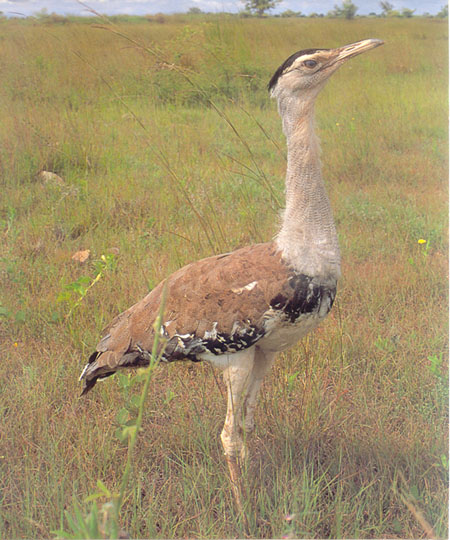Living on the Edge
--Shivani Thakur
The most famous resident of Rajasthan and also its State Bird, the Great Indian Bustard, is on the verge of extinction. After the great debate on tiger conservation
in Sariska and Ranthambore, the Great Indian Bustard or Godawan has also become a priority for the state government.
Listed on the endangered red list of IUCN, the Great Indian bustard is the most endangered member of the bustard family in the world. This tall majestic bird was almost
hunted to extinction by game lovers in its natural habitat.
Found mainly in Rajasthan, Gujarat, Madhya Pradesh and Andhra Pradesh the total population is now estimated to be around 1000; with about 30 in Andhra Pradesh and rest in Rajasthan and Gujarat.
The Great Indian Bustard is a tall long legged bird .The under parts and neck is white. There is a black crown on the forehead and the underbody is brown. This bird nests
in open ground and the males takes no part in incubation or care of the young ones. Only a single egg is laid at one time. The fledglings tend to remain with their mother until the following breeding season. The bustard feeds on beetles, grasshoppers, seeds
and groundnuts. 
These birds are locally extinct from 90 per cent of its former range and rest are found in the three sanctuaries, the Desert National Park (Rajasthan),
the Lala-Parjau sanctuary in western Kutch (Gujarat) and Rollapadu in Andhra Pradesh. The birds also come under Schedule I of Wildlife Protection Act of 1972.
Decline in safe living areas and choice of food and poaching is pushing it on to the edge. The wildlife in Desert National Park is dependent on the vegetation of the Oran-Gochar – a land with natural forests and planted forestry.
Its water bodies are all neglected and sources of water dry.
The land has shrunk due to loss of community control, land improvement measures, frequent droughts and famines.
The Bombay Natural History Society has formed a four-member task force for the bustard’s conservation at DNP in Rajasthan
which favors a Project Tiger sort of structured approach for saving the bird.
Andhra Pradesh is now planning to start a captive breeding scheme to help the birds bounce back from the brink of extinction. The state government has sought permission
from the Ministry of Environment and Forests to take up breeding. The Dean of Biodiversity Research center at Srisailam wants the breeding programme to be started soon. The breeding is crucial because of rapid changes around Rollapadu. The birds are not only
losing their habitat but also being deprived of their staple food such as millet and rabi.
Similarly the Gujarat Ecological Education and Research
(GEER) Foundation, Gandhinagar has started a project on this bird. A grant of Rs 5 lakh from central governments Ministry of Environment and Forests has given it the necessary push. The GEER foundation director C N Pandey says that the project’s main
objective would be to get information of the population of the bird where it was recently spotted mainly in North Gujarat. The project would get help from state forest department and local NGO’s who would redo the census thrice a year depending upon varying
seasons as the birds change their habitat with changing seasons.
Hope arises from all these projects.
If the efforts pay the Indian Bustard would again roam freely in these lands.
(Photograph of the Great Indian Bustard courtesy BNHS)